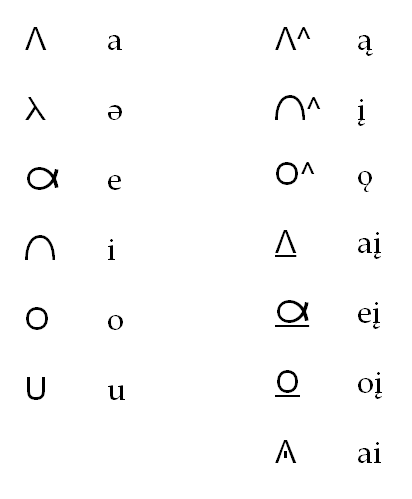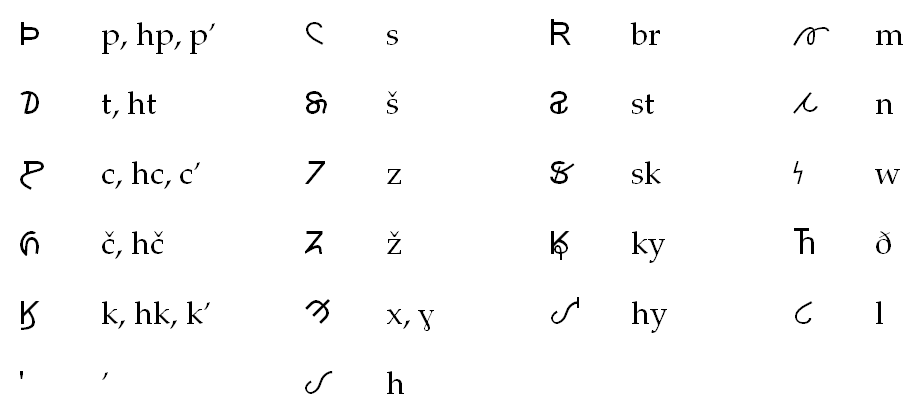Osage alphabet
| Osage | |
|---|---|
|
| |
| Type | |
| Languages | Osage |
Time period | 2006– |
Parent systems | |
| Direction | Left-to-right |
| ISO 15924 |
Osge, 219 |
Unicode alias | Osage |
| U+104B0–U+104FF | |
In 2006, a new script was promulgated for the Osage language. Unlike previous orthographies for Osage, which used the Latin script, the new Osage script has distinct letter shapes, though its derivation from Latin is apparent. It is used on the website of the language department of the Osage Nation.[1]
In its original form, Osage was a non-phonemic alphabet, which from a technical perspective is called a defective alphabet, because it did not distinguish the stop series, which are central to Osage phonology.
In February 2014 a conference was held by the script's creator, Herman Mongrain Lookout, and the staff at the Osage Nation Language Department, along with UCS expert Michael Everson. They settled on a more detailed representation of the sounds in Osage and accounted for and documented changes in the Osage language. The result of the conference was a script reform; this included introduction of lower case, abolition of two ligatures, and the addition of at least one new character. The reformed alphabet is phonemic.[2]
The Osage alphabet was included in Unicode version 9.0 in June 2016 in the Osage block.[3]
Letters
For the pronunciation of the letters of the alphabet, see Osage language#Phonology or the links below.
The vowels are as follows:

It is not clear which vowel the "ə" is, as it is not phonemic in Osage, but it may appear nasalized (not shown). The a comes from Latin ⟨A⟩ (without the crossbar, as in the NΛSΛ logo), e from Latin ⟨a⟩ (cursive; the English letter a is pronounced rather like Osage e). The source for i is obscure, though Latin ⟨I⟩ does appear in the diphthong ai.
The consonants are as follows:

The alphabet does not distinguish the ejective, fortis, and lenis series of obstruents. The aspirate series are written as sequences such as tx and kš. The use of ky and hy is unclear.
The source of p is Latin ⟨P⟩, that of t is Latin ⟨D⟩ (an alternative transcription of Osage t), č is from ⟨Ch⟩, k from ⟨K⟩. C is from ⟨T⟩ and the Osage s. S and z are the top halves of ⟨S⟩ and ⟨Z⟩; š and ž are derived from adding a tail to the full letters, much like Latin ⟨ʒ⟩. Br, st, sk are ligatures of those letters, m, n, and l appear to be from cursive, and ð is a ligature of ⟨Th⟩, which is how it is often transcribed. W is a partial ⟨w⟩. X might be from cursive ⟨x⟩; h is obscure.
Punctuation
Words are separated by a space, syllables by a full stop.
Unicode
The Osage alphabet was added to the Unicode Standard in June, 2016 with the release of version 9.0.
The Unicode block for Osage is U+104B0–U+104FF:
| Osage[1][2] Official Unicode Consortium code chart (PDF) | ||||||||||||||||
| 0 | 1 | 2 | 3 | 4 | 5 | 6 | 7 | 8 | 9 | A | B | C | D | E | F | |
| U+104Bx | 𐒰 | 𐒱 | 𐒲 | 𐒳 | 𐒴 | 𐒵 | 𐒶 | 𐒷 | 𐒸 | 𐒹 | 𐒺 | 𐒻 | 𐒼 | 𐒽 | 𐒾 | 𐒿 |
| U+104Cx | 𐓀 | 𐓁 | 𐓂 | 𐓃 | 𐓄 | 𐓅 | 𐓆 | 𐓇 | 𐓈 | 𐓉 | 𐓊 | 𐓋 | 𐓌 | 𐓍 | 𐓎 | 𐓏 |
| U+104Dx | 𐓐 | 𐓑 | 𐓒 | 𐓓 | 𐓘 | 𐓙 | 𐓚 | 𐓛 | 𐓜 | 𐓝 | 𐓞 | 𐓟 | ||||
| U+104Ex | 𐓠 | 𐓡 | 𐓢 | 𐓣 | 𐓤 | 𐓥 | 𐓦 | 𐓧 | 𐓨 | 𐓩 | 𐓪 | 𐓫 | 𐓬 | 𐓭 | 𐓮 | 𐓯 |
| U+104Fx | 𐓰 | 𐓱 | 𐓲 | 𐓳 | 𐓴 | 𐓵 | 𐓶 | 𐓷 | 𐓸 | 𐓹 | 𐓺 | 𐓻 | ||||
| Notes | ||||||||||||||||
References
- ↑ Osage Nation Language Department
- ↑ Michael Everson; Herman Mongrain Lookout; Cameron Pratt (2014-09-21). "Final proposal to encode the Osage script in the UCS" (PDF). ISO/IEC JTC1/SC2/WG2, Document N4619. Retrieved 2015-01-10.
- ↑ Unicode version 9.0.0
External links
- 2014 Language Presentation at Osage Nation, includes non-native sound files for some letters
- Presentation at Native-languages.org, along with various romanizations
- Osage font download
- Typeface adapts Osage language for Unicode